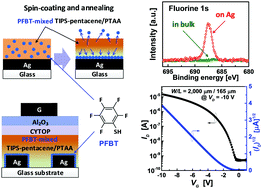Self-forming electrode modification in organic field-effect transistors†
Abstract
We report on self-forming electrode modification by mixing 2,3,4,5,6-pentafluorothiophenol (PFBT) directly into the solution of the organic semiconductor prior to film formation on top of existing metal electrodes. During the formation of the semiconductor layer from the mixed solution, PFBT chemisorbs on the underlying source/drain electrodes and modifies their electronic properties. The modification of evaporated silver, gold, or printed silver electrodes with PFBT is analyzed by X-ray photoelectron spectroscopy. The use of this self-forming electrode modification is applied to solution-processed p-channel top-gate 6,13-bis(triisopropylsilylethynyl)pentacene/poly[bis(4-phenyl) (2,4,6-trimethylphenyl) amine] organic field-effect transistors (OFETs) that comprise bare silver or gold source/drain electrodes. The proposed new method simplifies device fabrication while yielding OFETs with a performance level that is comparable to that of reference devices in which the metal electrodes are modified with PFBT prior to the fabrication of the semiconductor layer.


 Please wait while we load your content...
Please wait while we load your content...